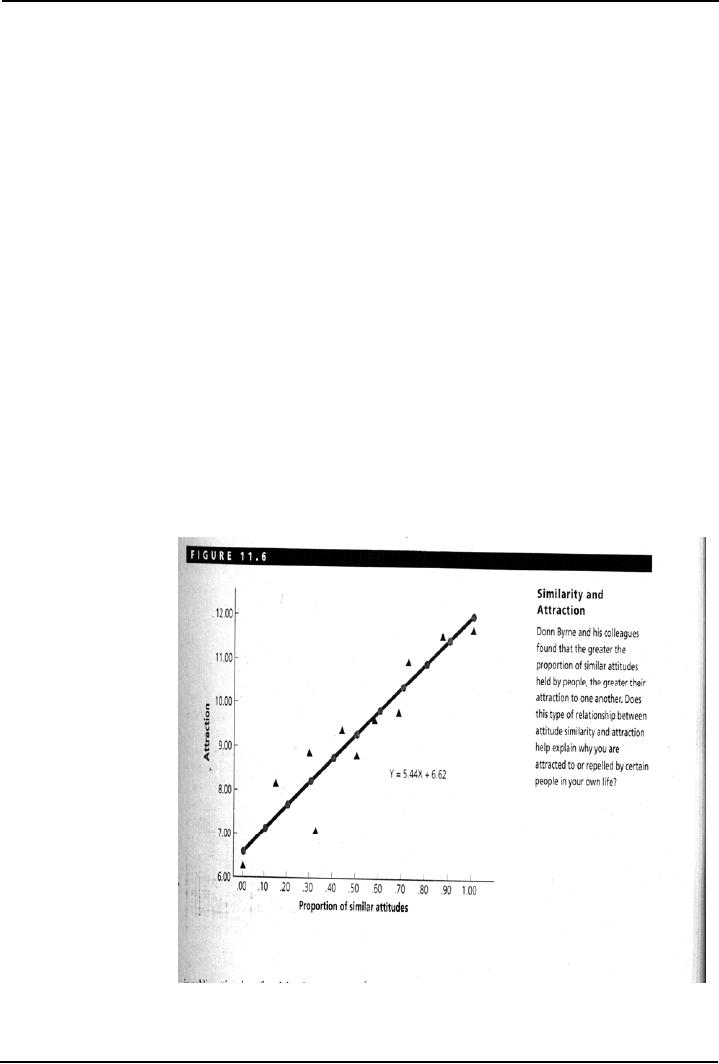 |
INTERPERSONAL ATTRACTION (CONTINUE……..):Physical attractiveness |
| << INTERPERSONAL ATTRACTION:Reasons for affiliation, Theory of Social exchange |
| INTIMATE RELATIONSHIPS:Applied Social Psychology Lab >> |

Social
Psychology (PSY403)
VU
Lesson
29
INTERPERSONAL
ATTRACTION (CONTINUE........)
Aims
To
introduce the concept of interpersonal
attraction and related
concepts
Objectives
·
To
describe the characteristics of others as
important factors in interpersonal
attraction.
·
To
discuss the situations when social
interaction becomes
problematic
Characteristics
of others & attraction
The
following characteristics of others have
been involved in interpersonal
attraction:
·
Physical
attractiveness
·
Similarity
·
Desirable
personal attributes
Physical
attractiveness
Despite
the old sayings that "beauty is
only skin deep" and "you
can't judge a book by its
cover", We tend
to
operate according to Aristotle's
2000-year-old pronouncement that
"personal
beauty is a greater
recommendation
than any letter of
introduction."
Research
on physical attractiveness
stereotype
What
is beautiful is good:
In
one of the first studies of the physical
attractiveness stereotype, Karen
Berscheid, and Elaine
[Walster]
Hatfield
(1972) asked college
students to look at pictures of men and
women who either were
good-
looking,
average, or homely and to then evaluate
their personalities. Results
indicated that the
students
tended
to assume that physically
attractive persons possessed a
host of socially desirable personality
traits
relative
to those who were unattractive.
This physical attractiveness effect
has also been documented
in
Hollywood
movies. Steven Smith and his coworkers
(1999) asked people to watch
the 100 most popular
movies
between 1940 and 1990 and to evaluate the
movies' main characters. Consistent with
the physical
attractiveness
stereotype, beautiful and handsome
characters were significantly more likely
to be portrayed
as
virtuous, romantically active, and
successful than their less
attractive counterparts. Over the
past thirty-
five
years, many researchers have
examined this stereotype, and
two separate meta-analyses of
these
studies
reveal that physically
attractive people are
perceived to be more sociable, successful,
happy,
dominant,
sexually warm, mentally
healthy, intelligent, and socially
skilled than those who
are unattractive
(Eagly
et al., 1991; Feingold
1992).
Cross-cultural
differences:
Although
these findings are based
solely on samples from
individualist cultures, the
physical
attractiveness
stereotype also occurs in collectivist
cultures, but its content is a bit
different.
Research
with children:
The
positive glow generated by
physical attractiveness is not reserved
solely for adults. Attractive
infants
are
perceived by adults as more likable, sociable,
competent, and easy to care
for than unattractive
babies
(Casey
& Ritter, 1996).
Attractiveness
and job-related
outcomes:
Field
and laboratory studies conducted in both
individualist and collectivist cultures
indicate that
physical
attractiveness
does have a moderate impact in a
variety of job-related outcomes,
including hiring,
salary,
116

Social
Psychology (PSY403)
VU
and
promotion decisions. In one representative study,
Irene Frieze and her coworkers (1991)
obtained
information
on the career success of more than
700 former MBA graduates of
the 1973 to 1982 classes
at
the
University of Pittsburgh. They
also judged former students'
facial attractiveness based on photos
taken
during
their final year in school.
Results indicated that there
was about a $2,200
difference between the
starting
salaries of good-looking men and
those with slow average
faces. For women, facial
attractiveness
did
not influence their starting
salaries, but it did
substantially impact their
later salaries. Once
hired,
women
who were above average in facial
attractiveness typically earned $4,200
more per year than
women
who
were below average in attractiveness. For
attractive and unattractive
men, this difference in
earning
power
per year was $5,200.
Further, although neither
height nor weight affected a
woman's starting
salary,
being
20% or more overweight reduced a
man's starting salary by more than
$2,000. Overall, the
research
literature
informs us that physical
appearance does indeed
influence success on the
job.
Obesity
and attractiveness
bias:
·
People
who are obese are
stigmatized and face discrimination in
the workplace.
·
The
negative view occurs because
people are seen as responsible
for their weight.
·
Anti-fat
prejudice is strongest in individualistic
cultures (Crandall et al.,
2001).
Who
is Attractive?
Culture
plays a large role in
standards of attractiveness. However,
people do tend to agree on
some features
that
are seen as more
attractive:
·
Statistically
"average" faces
·
Symmetrical
or balanced faces
Taking
into consideration all the cross-cultural
research, it appears that -
all things being equal--men
prefer
women
with relatively low
waist-to-hip ratios because
this body type signifies
youth, fertility, and
current
non-pregnancy.
However, in environments where people
face frequent food
shortages, male preference
shifts
to a higher female waist-to-hip
ratio because this body
type signifies greater ability to
both produce
and
nurse offspring when food is
scarce.
Beyond
body type, there is also evidence
that there may be universal
standards of
facial attractiveness. For
example,
a number of studies indicate that we
prefer faces in which right
and left sides are
well matched or
symmetrical
(Chen
et al., 1997; Mealey et al.,
1999). Facial symmetry was
one thing that Lucy
Grealy's
plastic
surgeons tried unsuccessfully to restore
in countless operations (see lecture 28
for reference).
Evolutionary
psychologists contend that we refer
facial symmetry because
symmetry generally indicates
physical
health and the lack f
genetic defects,
Besides
symmetry influencing attractiveness,
studies of people's perceptions of young
men and women's
individual
faces and composite faces
(computer-generated "averages" of all the
individual faces),
indicate
that
what people judge most
attractive are faces that
represent the "average" face in the
population
(Langlois
et al., 1994). This tendency to
define physical attractiveness
according to the "average rule"
has
been
found in many cultures (Jones &
Hill, 1993; Pollard,
1995).
Evolutionary
psychologists further contend that,
besides symmetry and averageness,
youthfulness and
maturity
figure into facial attractiveness
judgments. Consistent with this
hypothesis, a number of studies
have
found that possessing
youthful or slightly immature
facial
features (large eyes, small
nose, full lips,
small
chin, delicate jaw) enhances
female attractiveness, while possessing
mature
facial
characteristics
related
to social dominance, broad forehead,
thick eyebrows, thin lips,
large jaw) increases
the
attractiveness
of males (Cunningham, 1986; Johnston
& Franklin, 1993).
Why
does attractiveness
matter?
·
People
believe attractiveness is correlated with
other positive characteristics
(consistent with
implicit
personality theory).
·
Being
associated with an attractive
other leads a person to be
seen as more attractive him or
herself.
·
According
to evolutionary theory, attractiveness
may provide a clue to health
and reproductive
fitness.
117

Social
Psychology (PSY403)
VU
Is
the attractiveness stereotype
accurate?
Alan
Feingold (1992b) conducted a meta-analysis of more
than ninety studies that
investigated whether
physically
attractive and physically
unattractive people actually
differed in their basic
personality traits.
His
analysis
indicated no significant relationships
between physical attractiveness and such
traits as
intelligence,
dominance, self-esteem, and mental
health.
Birds
of a feather really do flock
together: Similarity
Social
Psychological research generally
indicates that we are attracted to those
who are similar to
us.
Demographic
similarity:
Research
on high school friendships found
that students identified
their best friends as those
who were
similar
to them in sex, race, age, and
year in school.
Attitudinal
similarity:
In
Newcomb's boardinghouse study (as
mentioned previously), similarity in
age and family background
not
only
influenced interpersonal attraction,
but similarity in attitudes
also provided mutual liking,
Unlike
physical
and demographic characteristics, it generally
takes lime to learn another
person's attitudes. In
laboratory
studies, Dorm Byrne and
his colleagues accelerated the
getting-acquainted process by
having
participants
complete attitude questionnaires and later
"introducing" them to another person by
having
them
read his or her responses to a
similar questionnaire (Byrne &
Nelson, 1965; Schoneman et
al., 1977).
The
researchers had actually filled
out the questionnaire so that the
answers were either similar
or
dissimilar
to the participants' own attitudinal
responses. The results
showed that the participants
expressed
much
stronger liking when they
thought they shared a greater
percentage of similar attitudes
with the
individual.
This finding is important,
for it suggests that
the
proportion of similar
attitudes is more
important
than the actual number
of
similar attitudes. Thus, we should be
more attracted to someone who
agrees
with us on four of six topics
(66 percent similarity) than
one with whom we share
similar opinions
on
ten of twenty-five topics (40 percent
similarity). The graph given
below describes more clearly
the
relationship
between attitude similarity and
attraction.
Similarity
in physical
attractiveness:
In
fact, researchers who
have
observed couples
in
public settings have
found
that they
are
remarkably
well
matched
in physical
attractiveness
(Feingold,
1988). One
possible
reason why
we
are
attracted to potential
romantic
partners who
are
similar to us in
physical
attractiveness
is
that we estimate they
have
about the same
social
exchange value
as
us.
This
tendency to be
attracted
to others who
are
similar to us in particular
characteristics, such as physical
attractiveness, is known as the matching
hypothesis,
and
it appears to be a socially shared
belief (Stiles et al.,
1996). We expect that people
who
118

Social
Psychology (PSY403)
VU
have
similar levels of physical attractiveness
will be more satisfied as couples
than those who are
phys-
ically
mismatched.
Desirable
Personal Attributes
·
Warmth
o
People
appear warm when they have a
positive attitude and
express liking, praise,
and
approval.
Nonverbal
behaviors such as smiling, attentiveness,
and expressing emotions also
o
contribute
to perceptions of warmth.
·
Competence
o
We
like people who are
socially skilled, intelligent,
and competent.
The
type of competence that
matters most depends on the nature of the
relationship., e.g.,
o
social
skills for friends,
knowledge for professors
will be preferred. However,
being "too
perfect"
can be off-putting
When
social interaction becomes
problematic
Whenever
we approach others, we
risk rejection. Even
if others do accept
our
social
overtures, there is the further possibility
that we may commit a social
blunder that
will
cause them to form a negative impression
of us.
Social
anxiety can keep us isolated
from others
Social
anxiety is the unpleasant
emotion we experience due to our
concern with interpersonal
evaluation
(Leary
& Kowalski, 1995). This
anxiety is what causes us to
occasionally (or frequently)
avoid social
interaction.
We can experience social anxiety even
when alone: simply
anticipating social interaction is
often
sufficient to arouse
it.
The
unfortunate consequence of social
anxiousness is that it can
trap a person into
increasingly unpleasant
social
exchanges (DePaulo et al.,
1990). Highly socially
anxious people anxiously expect,
readily perceive,
and
intensely react to rejection
cues in their surroundings (Downey et
al., 2004). For example,
they are
more
attentive to faces with
negative expressions than
they are to those with
positive or neutral
expressions
(Pishyar
et al., 2004). This
attentional bias in noticing
negative social feedback results in
highly anxious
persons
often acting in ways--avoiding eye
contact, appearing nervous and jittery--that
fulfill the self-
prophecy
(Pozo et al., 1991).
Defining
and measuring loneliness
Loneliness
is
defined as having a smaller or less
satisfying network of social and
intimate relationships
than
we desire (Green et al.,
2001).
Age,
gender, culture and
loneliness
Numerous
studies have identified the
young--adolescents and young adults--as
the loneliest age groups
(Peplau
et al., 1982), As people mature and
move beyond the young adult
years, their loneliness
tends to
decrease
until relatively late in
life, when factors such as
poor health and the death of loved
ones increase
social
isolation (Green et al.,
2001). One reason why
adolescents and young adults may be
lonelier than
older
individuals is that young
people face many more social
transitions, such as falling in and
out of love
for
the first time, leaving
family and friends, and training
and
searching
for a full-time job--all of
which
can
cause loneliness (Oswald &
Clark, 2003).
There
are clear age differences in
loneliness, but gender differences
are not as clear-cut. Some
studies have
found
a slight tendency for women to
report greater loneliness than
men, yet other studies
fail to find any
differences
at all (Archibald et al.,
1995; Brage et al., 1993). Despite
any firm evidence for
gender
differences
in the degree
of
loneliness, there does appear to be
evidence that men and women
feel lonely
119

Social
Psychology (PSY403)
VU
for
different reasons. Men tend
to feel lonely when deprived
of group interaction; women
are more likely to
feel
lonely when they lack
one-to-one emotional sharing (Stokes
&
Levin,
1986).
Social
skills deficits and
loneliness
Similar
to the negative consequences of social
anxiousness, chronically lonely
people often think
and
behave
in ways that reduce their
likelihood of establishing new and
rewarding relationships. Studies
conducted
with college students
illustrate some of these
self-defeating patterns of behavior.
Typically, in
these
investigations, students who
are strangers to one another are
asked to briefly interact in
either pairs or
groups,
after which they rate
themselves and their partners on
such interpersonal dimensions as
friendliness,
honesty, and openness, Compared with
individuals, nonlonely college
students rate themselves
negatively
following such laboratory
interactions. They perceive
themselves as having been
less friendly,
less
honest and open, and less
warm (Christensen & Kashy, 1998;
Jones et al., 1983). They
also expect
those
who interact with them to
perceive them in this negative
manner. This expectation of
failure in social
interaction
appears all the more hopeless to the
chronically lonely because
they believe that improving
their
social
life is beyond their control
(Duck et al., 1994).
Reading
·
Franzoi,
S. (2003). Social
Psychology. Boston:
McGraw-Hill. Chapter 11.
Other
Readings
·
Lord,
C.G. (1997). Social
Psychology. Orlando:
Harcourt Brace and Company. Chapter
8.
·
David
G. Myers, D. G. (2002). Social
Psychology (7th ed.).
New York:
McGraw-Hill.
120

Social
Psychology (PSY403)
VU
Lesson
30
INTIMATE
RELATIONSHIPS
Aims
To
introduce the concept of intimate
relationships, attachment styles and later
adult relationships
Objectives
To
discuss what is
intimacy?
To
describe how self concepts
of important others are manifested in
one's own self
schemas
To
discuss attachment as an adaptive
response
To
describe link between different
attachment styles & later adult
relationships:
To
discuss attachment styles and romantic
relationships as well as
friendships
Applied
Social Psychology
Lab
In
the previous lecture, it was
pointed out that social
skill deficit is likely
cause of loneliness, which is
the
primary
reason of low self esteem.
Applied social Psychology Lab
exercise highlights the
appropriate
social
skills, as mentioned below,
required for interpersonal
interaction.
Amount
of personal attention given to one's
partner in interaction
Ability
to recognize and conform to social
norms
Regulating
one's mood prior to commencing
social interaction
Training
includes observation, modeling,
role playing, observing
one's own interaction on
videotape,
speaking
on phone, giving compliments, actively
listening, etc.
Research
has indicated that
participation in this kind of
training shows improvement in social
skills and an
increased
level of social satisfaction (Erwin,
1994).
Student's
Activity
In
the following exercise, you are to
think of one person who is a
close friend, and another person
who you
know
fairly well but whom
you believe you are
unlikely to become close to.
After you have decided on the
people
who will be rating, first
rate yourself on whether or not
you have each of the characteristics
listed by
placing
a check on the line for each
characteristic that describes you.
Then do the same thing for
your close
friend
and for your acquaintance.
Traits
Self
Close
friend
Acquaintance
/
Non-Friend
Outgoing
Soft-Hearted
Organized
Creative
Independent
Conscientious
Quiet
Tough-minded
Efficient
Calm
Practical
Adventurous
Trusting
Passive
Generous
121
Table of Contents:
- INTRODUCTION TO SOCIAL PSYCHOLOGY:Readings, Main Elements of Definitions
- INTRODUCTION TO SOCIAL PSYCHOLOGY:Social Psychology and Sociology
- CONDUCTING RESEARCH IN SOCIAL PSYCHOLOGY:Scientific Method
- CONDUCTING RESEARCH IN SOCIAL PSYCHOLOGY:Evaluate Ethics
- CONDUCTING RESEARCH IN SOCIAL PSYCHOLOGY RESEARCH PROCESS, DESIGNS AND METHODS (CONTINUED)
- CONDUCTING RESEARCH IN SOCIAL PSYCHOLOGY OBSERVATIONAL METHOD
- CONDUCTING RESEARCH IN SOCIAL PSYCHOLOGY CORRELATIONAL METHOD:
- CONDUCTING RESEARCH IN SOCIAL PSYCHOLOGY EXPERIMENTAL METHOD
- THE SELF:Meta Analysis, THE INTERNET, BRAIN-IMAGING TECHNIQUES
- THE SELF (CONTINUED):Development of Self awareness, SELF REGULATION
- THE SELF (CONTINUE…….):Journal Activity, POSSIBLE HISTORICAL EFFECTS
- THE SELF (CONTINUE……….):SELF-SCHEMAS, SELF-COMPLEXITY
- PERSON PERCEPTION:Impression Formation, Facial Expressions
- PERSON PERCEPTION (CONTINUE…..):GENDER SOCIALIZATION, Integrating Impressions
- PERSON PERCEPTION: WHEN PERSON PERCEPTION IS MOST CHALLENGING
- ATTRIBUTION:The locus of causality, Stability & Controllability
- ATTRIBUTION ERRORS:Biases in Attribution, Cultural differences
- SOCIAL COGNITION:We are categorizing creatures, Developing Schemas
- SOCIAL COGNITION (CONTINUE…….):Counterfactual Thinking, Confirmation bias
- ATTITUDES:Affective component, Behavioral component, Cognitive component
- ATTITUDE FORMATION:Classical conditioning, Subliminal conditioning
- ATTITUDE AND BEHAVIOR:Theory of planned behavior, Attitude strength
- ATTITUDE CHANGE:Factors affecting dissonance, Likeability
- ATTITUDE CHANGE (CONTINUE……….):Attitudinal Inoculation, Audience Variables
- PREJUDICE AND DISCRIMINATION:Activity on Cognitive Dissonance, Categorization
- PREJUDICE AND DISCRIMINATION (CONTINUE……….):Religion, Stereotype threat
- REDUCING PREJUDICE AND DISCRIMINATION:The contact hypothesis
- INTERPERSONAL ATTRACTION:Reasons for affiliation, Theory of Social exchange
- INTERPERSONAL ATTRACTION (CONTINUE……..):Physical attractiveness
- INTIMATE RELATIONSHIPS:Applied Social Psychology Lab
- SOCIAL INFLUENCE:Attachment styles & Friendship, SOCIAL INTERACTIONS
- SOCIAL INFLUENCE (CONTINE………):Normative influence, Informational influence
- SOCIAL INFLUENCE (CONTINUE……):Crimes of Obedience, Predictions
- AGGRESSION:Identifying Aggression, Instrumental aggression
- AGGRESSION (CONTINUE……):The Cognitive-Neo-associationist Model
- REDUCING AGGRESSION:Punishment, Incompatible response strategy
- PROSOCIAL BEHAVIOR:Types of Helping, Reciprocal helping, Norm of responsibility
- PROSOCIAL BEHAVIOR (CONTINUE………):Bystander Intervention, Diffusion of responsibility
- GROUP BEHAVIOR:Applied Social Psychology Lab, Basic Features of Groups
- GROUP BEHAVIOR (CONTINUE…………):Social Loafing, Deindividuation
- up Decision GROUP BEHAVIOR (CONTINUE……….):GroProcess, Group Polarization
- INTERPERSONAL POWER: LEADERSHIP, The Situational Perspective, Information power
- SOCIAL PSYCHOLOGY APPLIED: SOCIAL PSYCHOLOGY IN COURT
- SOCIAL PSYCHOLOGY APPLIED: SOCIAL PSYCHOLOGY IN CLINIC
- FINAL REVIEW:Social Psychology and related fields, History, Social cognition